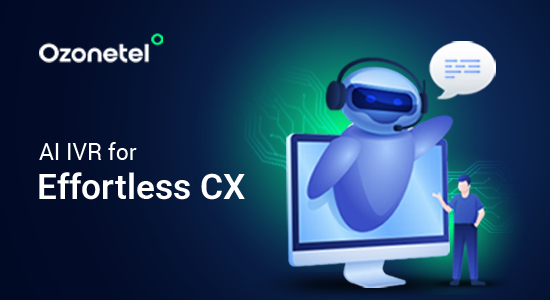- Resources
- Top Digital Transformation Trends of 2024
Top Digital Transformation Trends of 2024

Businesses are pouring billions into revamping everything from customer experience to employee workflows, and with good reason. A study by PwC found that nearly half of all companies credit digital transformation with boosting customer experience and satisfaction. That’s no surprise – think about the last time you interacted with a brand online. But on the flip side, one bad experience and 86% of us are out the door.
The good news? The customer experience management market is expected to grow to nearly $20.4 billion by 2028, and that’s just one area. Companies that cater to the needs of their customers by keeping up with the latest digital transformation trends are setting themselves up for success. So, what are the hottest trends to watch in 2024? Keep reading to find out!
In this article, we will explore:
What is Digital Transformation
Digital transformation refers to the process of integrating digital technologies across all areas of a business to fundamentally change how it operates and delivers value to customers. It involves reimagining business models, and strategies to leverage the capabilities of technologies such as cloud computing, artificial intelligence and data analytics.
Why is Digital Transformation Important?
These emerging technologies are disrupting industries and reshaping the competitive landscape. How? Organizations that embrace the upcoming digital transformation trends can streamline processes, reduce costs, improve customer experiences, and tailor their products and services according to the customer’s needs.
Moreover, digital transformation has facilitated the entry into new markets and revenue streams. Companies can leverage digital platforms to reach global customers, offer personalized services, and explore innovative business models that were previously unattainable. The ability to collect and analyze vast amounts of customer data through digital channels allows businesses to identify untapped opportunities and tailor their offerings accordingly.
These technologies are not just improving existing business models but also paving the way for innovative ones. Businesses that embrace these technologies are likely to stay ahead in the competitive landscape, offering superior value to their customers. Let’s look at the top digital transformation trends of 2024.
14 Best Digital Transformation Trends of 2024
That was all about why it is important to keep up with the latest digital transformation trends. But, considering it is such a broad sector, which trends should you focus on? Well, here is a list of the top 13 digital transformation trends that will be dominating 2024:
Generative AI
Generative AI refers to artificial intelligence models that can generate new data, such as text, images, audio, or video, based on the training data they receive. The market for Generative AI was valued at $10.5 billion in 2022 and is expected to skyrocket to a staggering $191.8 billion by 2032, growing at a compound annual growth rate (CAGR) of 34.1%. This meteoric rise is a testament to the transformative potential of Generative AI and its ability to streamline processes, enhance customer interactions, and drive innovation.
One of the key benefits of Generative AI is its capacity to automate tasks that have traditionally been labor-intensive and time-consuming. By leveraging models like Generative Adversarial Networks (GANs), Transformer-based Models, Diffusion Models, and Large Language Models (LLMs), you can streamline content creation, automate legal and financial processes, and even generate design pieces.
This not only frees up valuable employee time but also reduces costs associated with manual labor, allowing your business to operate more efficiently.
Customer Data Platforms (CDP)
Customer Data Platforms (CDPs) offer a centralized solution for collecting, organizing, and analyzing customer data from various sources, providing a comprehensive view of each customer’s journey. This enables businesses to gain valuable insights into customer preferences, behaviors, and pain points, allowing them to make informed decisions that drive conversions and enhance customer satisfaction.
Moreover, customer Experience (CX) platforms have emerged as powerful tools that complement CDPs, enabling businesses to create seamless and personalized interactions across all customer touchpoints. These platforms integrate data from various sources, including CDPs, to provide a holistic view of the customer journey, allowing companies to identify areas for improvement and implement targeted strategies to enhance the overall customer experience.
Unified CX Platform
A unified CX platform encompasses multiple components: Contact Center as a Service (CCaaS), CPaaS(Communication Platform as a service), CDP (Customer Data Platform), Conversational AI, and CRM Integrations. It consolidates multiple customer touchpoints into a single interface, enabling businesses to deliver a seamless and personalized customer experience across various channels. This platform empowers businesses to understand customer behavior, preferences, and feedback, thereby driving customer satisfaction and loyalty.
By aggregating data from various sources such as CRM systems, social media, and customer feedback, businesses can create unified customer profiles and deliver tailored interactions. They can leverage AI to continually track and analyze ongoing customer conversations, automate routine interactions, and monitor and manage agent performance. Ultimately, a Unified CX Platform stands as a key digital transformation trend and is a strategic investment that can significantly boost a company’s customer-centricity and competitive edge.
Hybrid Workforce Model
The hybrid workforce model gained significant traction during the COVID-19 pandemic, when companies were forced to adapt to remote work scenarios. However, as the world gradually reopened, many organizations recognized the benefits of this approach, with 54% of employees who work remotely expressing a preference for a hybrid arrangement that combines office and home-based work.
This shift towards a hybrid workforce model offers numerous advantages for both employers and employees. For businesses, it presents an opportunity to reduce infrastructure costs while simultaneously attracting top talent by fostering a work-life balance that caters to the diverse needs of their workforce. By providing a flexible environment, companies can tap into a wider pool of skilled professionals, regardless of their geographical location.
Moreover, the hybrid workforce model promotes increased productivity and collaboration. By leveraging the right technologies and tools, teams can seamlessly work together, regardless of their physical location. This enables organizations to streamline workflows, centralize resources, and promotes a culture of innovation and creativity.
Low-Code, No Code
According to Gartner, the low-code no-code industry is projected to be worth a staggering $13.8 billion in 2023, and by 2024, these platforms are expected to account for over 65% of software development. The popularity of low-code and no-code can be attributed to their inherent benefits, including accessibility, rapid development, cost-effectiveness, and automation capabilities.
By democratizing software development, these tools enable organizations to empower citizen developers, reducing time-to-market and lowering development costs. Also, low-code and no-code platforms provide a versatile and efficient solution if you’re aiming to:
- Create customer-facing applications to enhance the customer experience
- Automate mundane business processes
- Build interactive dashboards and reports
- Develop chatbots and virtual assistants to streamline customer support
Moreover, the accessibility of these platforms addresses the pressing issue of the digital skills gap, which, according to reports, has resulted in staggering losses of £63 billion for the UK economy per year. By adopting low-code and no-code solutions, mid-sized enterprises can bridge this gap without the need for highly specialized software professionals, fostering a more inclusive and collaborative approach to software development.
Blockchain
The adoption of blockchain technology has been steadily increasing, with a staggering 81 of the top 100 companies currently leveraging its capabilities to facilitate digital transformation. The blockchain market share grew from $6.92 billion to $11.54 billion in 2022 and is projected to reach an impressive $19.36 billion by the end of 2023. These figures are a testament to the transformative potential of blockchain and its ability to revolutionize industries across the board.
One of the key advantages of blockchain is its ability to enable smart contracts – self-executing agreements with predetermined terms encoded directly into the code. These smart contracts eliminate the need for intermediaries, streamlining processes and reducing costs. In industries where secure and transparent transactions are critical, such as finance, real estate, and supply chain management, blockchain is disrupting traditional models and offering innovative solutions.
Moreover, blockchain’s decentralized and immutable nature ensures data integrity and tamper-resistance, making it an ideal choice for organizations dealing with sensitive information or seeking to enhance trust among stakeholders. From facilitating Know Your Customer (KYC) processes and credit reporting to enabling secure document transfers and tracking the source of funds, blockchain is providing businesses with a powerful tool to overcome workflow challenges and drive digital transformation.
Cloud Acceleration
According to Fortune Business Insights, the XaaS (Everything as a Service) market is projected to soar from $545.35 billion in 2022 to an impressive $2,378.07 billion by 2029. This staggering growth is fueled by the operational flexibility and predictability offered by the as-a-service consumption model, which encompasses Software as a Service (SaaS), Infrastructure as a Service (IaaS), and Platform as a Service (PaaS) offerings.
Cloud computing’s growing popularity can be attributed to its remarkable efficiency, accessibility, scalability, and enhanced security. By providing on-demand access to computer system resources, cloud solutions improve business efficiency by enabling remote working, reducing operational costs, fostering cross-department collaboration, and simplifying scalability. According to Microsoft, 80% of businesses report saving money, increased productivity, and improved security through cloud adoption.
Moreover, cloud solutions offer unparalleled accessibility, enabling employees, clients, and stakeholders to access information or applications from anywhere in the world through the internet. This is particularly beneficial for remote businesses or global organizations, as it facilitates seamless collaboration and communication.
Security is also a paramount concern for businesses in the digital age, and cloud computing offers a robust solution. Businesses report a 94% increase in security after adopting cloud solutions, reducing the risk of breaches and ensuring the safety of digital files, data, and programs.
Cybersecurity Focus
While the challenges are daunting, with the average cost of a data breach in 2022 reaching $4.35 million, there are glimmers of hope. Efforts in ransomware mitigation, such as encrypted data backups and snapshots, have led to a 40% decline in ransomware revenue between 2021 and 2022.
To maintain their cybersecurity posture, enterprises can implement a multi-layered approach. Keeping software up-to-date, monitoring networks for suspicious activity, and employing robust security measures such as firewalls, intrusion detection systems, and data encryption are essential steps.
Furthermore, quantum computing holds the promise of revolutionizing encryption and secure communication methods. By leveraging the power of quantum mechanics, technologies like quantum encryption and quantum key distribution (QKD) can provide unparalleled security for communication channels, rendering them impervious to interception or eavesdropping.
Democratization of AI
The democratization of AI is an emerging trend that aims to make artificial intelligence accessible and usable by all employees within an organization, not just those with technical or data science backgrounds. Organizations are democratizing AI by implementing user-friendly interfaces, low-code/no-code platforms, and intuitive tools that abstract away the complexities of AI models and algorithms.
These solutions enable employees to interact with AI systems without the need for extensive coding or machine learning expertise. For example, some companies are providing drag-and-drop interfaces that allow users to build and deploy AI models with minimal technical knowledge.
Also, the benefits of democratizing AI include:
- Increased innovation: By giving employees across the organization access to AI capabilities, companies can tap into a broader pool of ideas and perspectives, leading to innovative solutions and novel applications of AI.
- Enhanced efficiency: AI can automate repetitive tasks, freeing up employees’ time and allowing them to focus on higher-value activities, thereby improving overall efficiency and productivity.
- Better decision-making: AI can provide valuable insights and recommendations by analyzing large datasets, enabling data-driven decision-making across various business functions, such as marketing, sales, finance, and operations.
- Democratized expertise: AI democratization allows organizations to leverage the collective knowledge and expertise of their workforce, rather than relying solely on a small group of specialists.
- Upskilling and talent retention: By providing AI training and tools to employees, organizations can upskill their workforce, fostering a culture of continuous learning and improving talent retention.
Automation
According to Salesforce, a staggering 95% of IT and engineering leaders are prioritizing workflow automation within their organizations, recognizing its potential to break down silos, improve employee productivity, and enhance the customer experience. Moreover, 89% of workers report increased job satisfaction thanks to automation, underscoring its positive impact on employee morale and engagement.
Also, for enterprises, automation presents a myriad of opportunities to drive digital transformation. By leveraging Robotic Process Automation (RPA), businesses can automate repetitive, rule-based tasks such as data entry, invoice processing, report generation, and customer support inquiries. This not only reduces the risk of human error but also frees up valuable time for employees to focus on more strategic and creative endeavors.
Furthermore, workflow automation tools enable organizations to create and manage automated processes for tasks like routing, approvals, and notifications, streamlining operations and improving overall efficiency. Whereas, marketing automation platforms can streamline campaigns, email marketing, lead generation, and customer segmentation.
Also, sales automation enhances lead tracking, deal management, and forecasting, enabling more informed and data-driven decision-making.
Everything as a Service (XaaS)
“Everything as a Service” (XaaS) is a cloud-based approach that provides a comprehensive suite of services, ranging from software and infrastructure to data storage and processing power. At its core, the XaaS model represents an extension of the widely adopted Software as a Service (SaaS) model, taking it a step further by offering a plethora of services on demand. This shift towards a subscription-based model has been driven by the increasing demand for flexibility, scalability, and cost-effectiveness.
One of the key advantages of the XaaS model is its ability to provide seamless access to a wide range of services, eliminating the need for businesses to invest in and maintain physical hardware or expensive software licenses. This not only reduces operational costs but also fosters a collaborative and agile work environment, enabling teams to access the resources they need, whenever and wherever they need them.
Moreover, the XaaS model offers unparalleled scalability, allowing businesses to easily adjust their service consumption based on their evolving requirements. This flexibility is particularly valuable for companies experiencing rapid growth or those with fluctuating demands, enabling them to scale their resources up or down effortlessly.
Total Experience (TX)
According to Gartner, by 2024, organizations that prioritize the total experience (TX) – an integrated approach that combines CX and EX strategies – will outperform their competitors in satisfaction metrics for both CX and EX by an impressive 25%. This statistic underscores the profound impact that a holistic view of customer and employee experiences can have on a business’s success.
The rationale behind this trend is simple: when employees are empowered, motivated, and provided with an exceptional work environment, they are better equipped to deliver outstanding service and engage with customers in a meaningful and satisfying manner. By fostering a positive and supportive culture for your workforce, you create a ripple effect that ultimately enhances the customer experience and drives greater satisfaction, loyalty, and advocacy.
Moreover, the convergence of CX and EX initiatives offers a unique opportunity for businesses to leverage their existing technology investments and create superior shared experiences that drive value across the organization. MuleSoft predicts that an increasing number of top companies will consider total experience (TX) in 2023, particularly in areas where customer and employee journeys intersect, maximizing the impact of their digital transformation efforts.
IoT and 5G
IoT, which involves the integration of physical devices, sensors, and actuators into a vast network of interconnected “things,” has already demonstrated its transformative potential across various industries. From logistics and supply chain management to healthcare and agriculture, IoT devices are gathering invaluable data, enabling businesses to optimize processes, reduce waste, and introduce innovative services through data analysis.
However, the true potential of IoT can only be fully realized when integrated with 5G technology. With its promise of multi-gigabit data speeds, minimal latency, and improved network bandwidth, 5G is set to become the backbone that enables robust IoT deployments. This synergy between IoT and 5G will pave the way for groundbreaking applications, such as autonomous vehicles, smart cities, and remote patient monitoring, unlocking a world of possibilities.
Environmental Sustainability
The impact of climate change is undeniable, and the tech community has taken a proactive stance in addressing this pressing issue. According to a recent study by the United Nations, we are currently on track to witness a global temperature increase of 2.7°F in the coming decades, a scenario that would have detrimental consequences for all. This alarming reality has prompted companies like Amazon, Microsoft, Intel, and SAP to intensify their sustainability efforts, with Amazon’s Climate Pledge now boasting over 350 signatories.
However, environmental sustainability goes beyond corporate pledges and commitments. It is a holistic approach that encompasses optimizing energy consumption, reducing electronic waste, and adopting eco-friendly technologies. In this regard, big data analytics has emerged as a powerful tool, enabling businesses and smart cities to harness the power of data to identify patterns, trends, and insights that can drive sustainable practices.
For instance, utility companies are leveraging big data analytics to predict electricity demand with greater accuracy, allowing them to seamlessly integrate renewable sources of power into the grid with enhanced efficiency. By analyzing weather patterns, electricity usage records, and other critical data points, these organizations can optimize their power generation and delivery plans in real-time, boosting efficiency while significantly reducing their dependence on fossil fuels.
Conclusion
The digital transformation wave shows no signs of slowing down as we look ahead to 2024. Key trends like automation, cloud migration, low-code/no-code platforms, AI/machine learning, and the integration of blockchain, among others will continue to reshape how businesses operate.
However, successful digital transformation goes far beyond just adopting the latest technologies. It requires a cultural shift and an agile mindset to continuously adapt to evolving customer needs and market dynamics. This means that you must be willing to experiment, learn from failures, and pivot strategies as needed.
Want to see what Ozonetel can do for your company? Sign up today for a free 7-day trial.
Prashanth Kancherla
Chief Operating Officer, Ozonetel Communications
Over the past decade, Prashanth has worked with 3000+ customer experience and contact center leaders...
Chief Operating Officer, Ozonetel Communications
Over the past decade, Prashanth has worked with 3000+ customer experience and contact center leaders to comprehensively understand the need for effective and efficient customer communications at every step of their journey with a brand. Deeply embedded in today’s CCaaS ecosystem, he has been instrumental in Ozonetel's growth and contributed in various roles including product management, sales, and solution architecture.







